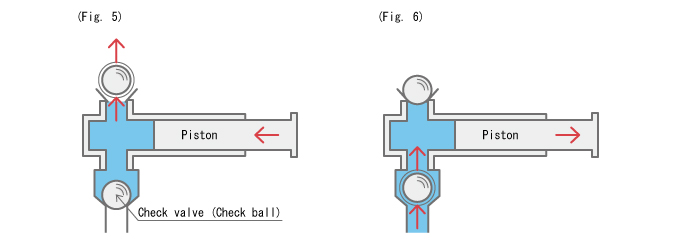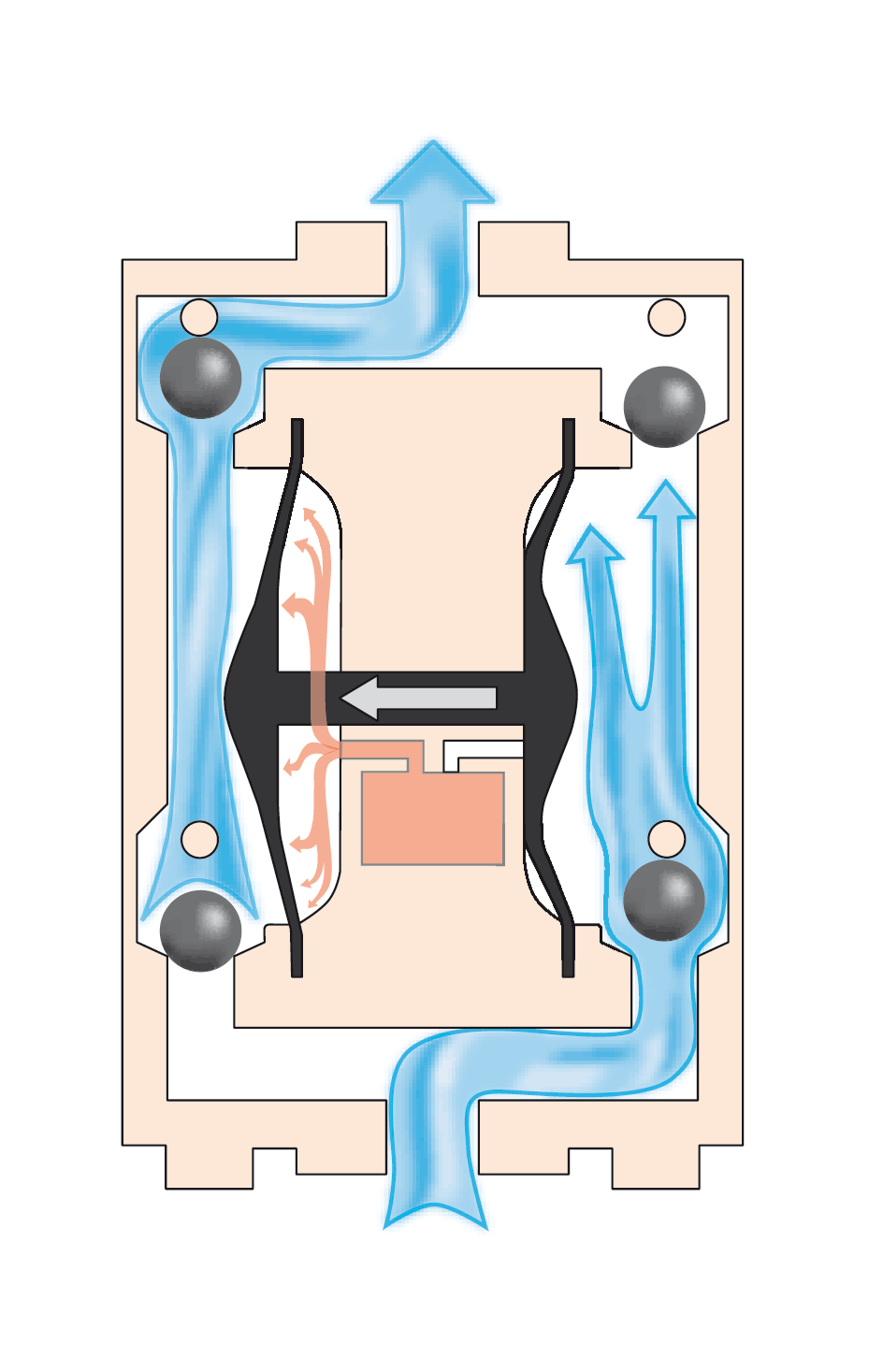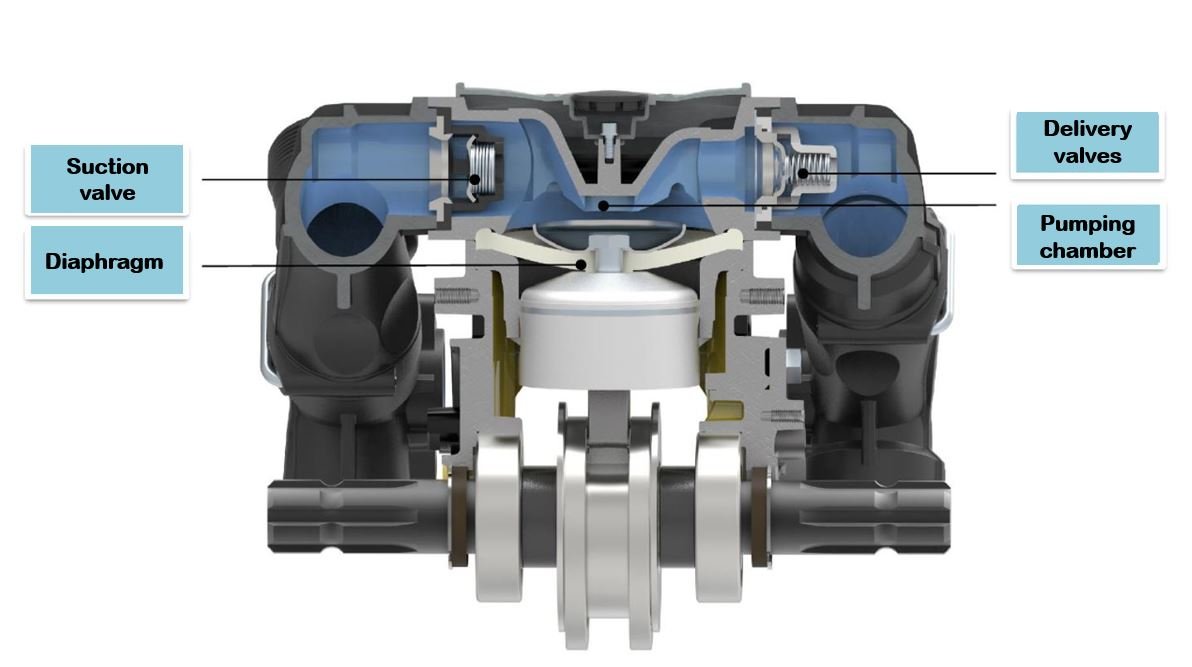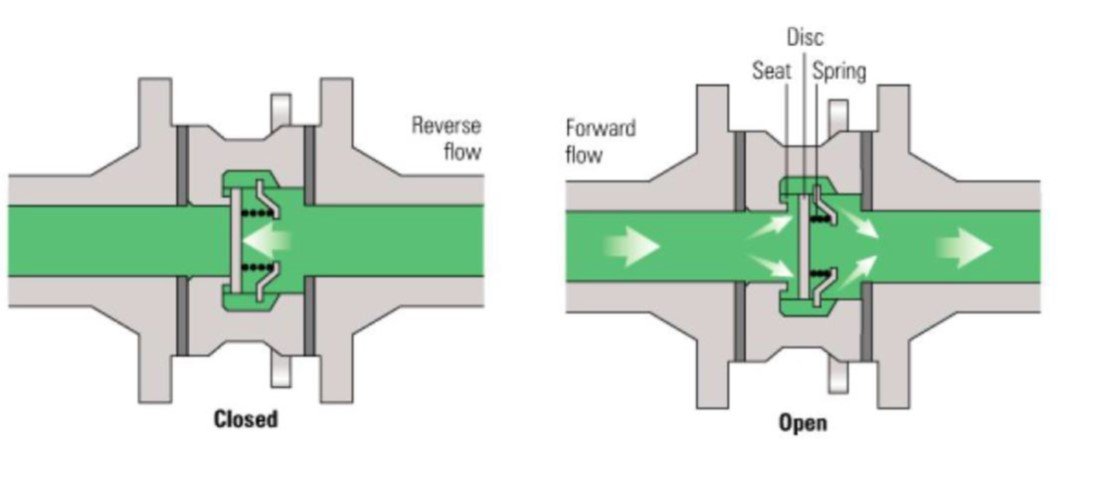Diaphragm pump parts generally fall into two groups, one that transmits mechanical energy from the motor to the pump and the other that delivers energy to the fluid. A diaphragm pump works to convert the mechanical energy of a motor into the dynamic pressure of a fluid.
⇒ View a Comprehensive List of Diaphragm Pumps for Sale and Their Suppliers ⇐
Basics of Diaphragm Pumps
A diaphragm pump (or a Membrane pump) is a type of positive displacement pump that applies a reciprocating action of a rubber, thermoplastic diaphragm, and proper valves on either side of the diaphragm to pump a fluid. The valves can be of the check valve, flap valves, butterfly valves, or any other form of shut-off valves.
Working Principle of Diaphragm Pumps
When the volume of the pump chamber is increased (as the diaphragm moves up), the pressure drops. So, the fluid is drawn into the chamber. As the diaphragm moves down and volume decreases, the chamber pressure increases. Then, the drawn fluid is pushed out. Finally, the diaphragm, which moves again upwards, draws fluid into the chamber and completes the cycle. This procedure is similar to what occurs in an internal combustion engine.
Diaphragm Pumps provide a tight seal between the drive device and the compression chamber, enabling the pump to move, compress, and evacuate the medium without the need for lubrication.
An elastomeric diaphragm is a versatile and dynamic seal that eliminates many other sealing methods limitations. In addition to not leaking, it offers little friction and can be created for low-pressure sensitivity. With suitable materials, diaphragms can seal over various pressures and temperatures without requiring lubricant or maintenance.

Diaphragm Pump Types
There are three types of diaphragm pumps:
In the first type, one side of the diaphragm is sealed in the pumped fluid, and the other is in the air or hydraulic fluid. The diaphragm can be flexed, which makes the chamber volume increase and decrease. A pair of non-return check valves block the reverse flow.
The second type employs positive volumetric displacement in which the main mover of the diaphragm is electro-mechanical, operating using a crank or geared motor drive, or is fully mechanical, such as with a lever or handle. This process flexes the diaphragm with simple mechanical operation, and one side of the diaphragm is open to the air.
The third type of diaphragm pump applies one or more unsealed diaphragms with the pumped fluid on either side. The diaphragms again are flexed and change the volume.
Characteristics of Diaphragm Pumps
Diaphragm pumps have the following notable specifications:
- Good suction lift is an important characteristic. Some of them are low-pressure pumps with low discharges, while others are able to produce higher flow rates, depending on the diaphragm effective operation diameter and stroke length. They can work with a relatively high concentration of solid content of sludge and slurries.
- Pump design separates the fluid from potentially sensitive internal pump components.
- Internal pump parts are often suspended and isolated within the oil to extent pump longevity
- Diaphragm pumps are suitable for running in abrasive and corrosive media to pump abrasive, corrosive, toxic, and flammable liquids.
- Diaphragm pumps can deliver the discharge pressure up to 1200 bar.
- Diaphragm pumps have great efficiencies, up to 97%.
- Diaphragm pumps can be used in artificial hearts.
- Diaphragm pumps offer proper dry running characteristics.
- Diaphragm pumps can be applied as filters in small fish tanks.
- Diaphragm pumps have excellent self-priming capabilities.
- Diaphragm pumps can work appropriately in highly viscous liquids.

Applications of Diaphragm Pumps
Diaphragm pumps are very versatile and can be implemented in almost any industry that requires fluid transfer. They are often employed to dewater or remove water in various industries. Because of their efficiency and accuracy, they can be used for purposes such as filling, dispensing, and metering.
They can provide lots of pressure for spraying and cleaning programs. Additionally, they are often utilized for filter press applications.
Components of Diaphragm Pumps
Diaphragm pumps include two major classes of parts: transmission and pumping unit, which converts the mechanical energy into pressure of the fluid.
Transmission
The mechanical parts transmit the mechanical energy from the source (i.e., a motor). The function of the transmission system is similar to that of a two-stroke combustion engine. However, the difference is that in the engine, the power is given from the piston to the shaft, while the direction of power transmission in the pump is reversed, which means power is transferred from the shaft to the piston and diaphragm.
All the mechanical components are placed in a crankcase in an oil bath with a special lubricant.
The piston is screwed to the central diaphragm part, causing it to oscillate and the periodic motion of suction and discharge.
The shaft performs a conversion from rotation to oscillating motion through an eccentric link to the connecting rod. The eccentric is a circular-shaped component that has an axis of rotation outside that of the rotational shaft. Since the main use of the diaphragm pump is agricultural spraying, it commonly has a rotational speed of 550 rpm. However, pumps with a rotational speed of 800 rpm are currently available.
Rotational Drive Shaft
This component receives energy from an electric, combustion or hydraulic engine. The shaft can take power from different motor types and in various ways. It is also employed as a transmission component for actuating extra-gears.
Connecting Rod-Crank
A connecting rod-crank system converts the rotational movement into oscillatory motion. This part connects the shaft to the piston which runs inside a cylinder or sleeve.
Pumping Unit
The pumping unit of a diaphragm pump includes: diaphragm, suction valve, pumping chamber, and delivery valve.

Diaphragm
The diaphragm is a rubber disc screwed over the piston using a bolt and a fixing disc that helps it to remain aligned during its strokes. It is the main component of the diaphragm pump. The diaphragm has two principal functions:
First, the diaphragm periodically expands and collapses the volume of the pumping chamber, which enables the pump to perform its task.
Second, this part separates the pumping and transmission parts and prevents the fluid from entering the mechanical unit and oil and severe damage to the pump.
Two distinct items define diaphragm characteristics: strength and material. The first is described by a numerical value measuring plastic deformation. The latter refers to the elasticity and hardness levels of the material, which determines diaphragm life, stiffness, and resistance against chemical and environmental corrosion.
Suction and Delivery Valves
Two valves are provided for each pumping unit: suction and delivery valves. The valves of a diaphragm pump are known as non-return (or one-way) valves because their purpose is to allow the fluid to pass in one direction and block it in the opposite direction. The two valves (suction valve and delivery valve) are installed in-line and operate in an alternate and opposite way.

Pump Chamber
The pumping chamber (or displacement cavity) is where the diaphragm stroke causes alternative volume expansions and contractions. In practice, this is the space between the hollow of the head and the upper part of the diaphragm. The internal form of the head has a major impact on pump performance.
Thus, its internal design has a concave dome that enables the pump to reach the highest pressure, vacuum, priming, and improving overall efficiency. Since this part is under large pressures and wearing process, the heads are usually designed in heavy-duty materials such as brass, plastic-coated aluminum, anodized aluminum, or techno polymers.
Manifolds
Manifolds are pipes gathering the several pumping units to simplify its installation in a way that a pump has one suction line and one delivery line. The delivery manifold collects the fluid from multiple pumping chambers and moves it to a single suction line. The internal pressure can reach high levels and cause severe damages. Therefore, equipping them with a safety valve is essential.
The suction manifold collects the fluid from the suction line and shares it among several pumping chambers. Because the internal pressure is negative, It does not require any special strength.
Manifolds are internal or external. Internal manifolds are more compact together with a lower price. External manifolds, on the other hand, provide more resistance with a lower risk of damage.
The latest generation manifolds are equipped with a water drain valve so that they can be discharged before stopping work in winter to prevent frost damage.
Safety Valves
A safety valve (or pressure relief valve) function is to decrease the consequences of very high pressures on the delivery line. Safety valves come with a spring-loaded bypass that is calibrated at a certain pressure. When the fluid pressure exceeds the spring pressure, the bypass opens. So, the overpressure is discharged, and the risk of breakage of tubes is eliminated.
Fittings
Manifolds are equipped with a straight or curved hose tail connecting the pump to the machine circuit.
Generally, the suction fitting includes a hose tail made of nylon or polypropylene because no pressure issue exists on the suction line.
For low-pressure pumps, up to 20 bar, the delivery fitting and the delivery taps are made of nylon or propylene. However, for high-pressure pumps, up to 50 bars are made of brass.
Accurate dimensioning of fittings is very important to prevent damage such as cavitation.
Oil Compensator
The oil compensator is a transparent box containing lubricating oil connected to the oil bath inside the crankcase. This component is applied to check the oil level and refill if necessary. So it allows the diaphragms to be oil-loaded during the delivery stroke and the mechanical elements to always be lubricated.
The oil compensator is always positioned over the pump, and the oil level has to always be above the highest diaphragm line.
The other important role of the oil compensator is to serve as a diaphragm breakage warning. In this case, oil and water are mixed together to form an emulsion inside the crankcase, which can be detected by its milky color inside the oil compensator. If this occurs, it is necessary to replace damaged diaphragms to prevent further problems.
Pressure Accumulator
The pressure accumulator (or pulsation dampener) acts to minimize or remove pulsations, prevent possible pipe hammering, decrease the load on the pump itself and diminish noise; in this way, the pumps have reduced wear and longer life.
The accumulator is placed on the delivery manifold (or remotely on the line). It absorbs the vibrations produced by the oscillating motion of the diaphragms.
Most vibrations are coordinated by synchronizing the motion of various pistons (phasing process). Therefore, pumps with more than four diaphragms (5 or 6 diaphragms) do not need a Pressure accumulator because they have a proper linear flow rate.
Buy Equipment or Ask for a Service
By using Linquip RFQ Service, you can expect to receive quotations from various suppliers across multiple industries and regions.
Click Here to Request a Quotation From Suppliers and Service Providers
Read More on Linquip
- Diaphragm Pump Parts List + Function & Application
- Parts of Water Pump
- Parts of Centrifugal Pumps
- Parts of Oil Pump
- 7 Parts of Gear Pump and Function + Diagram & Applications
- 10 Parts of Reciprocating Pumps + Function, Application and Working
- 20 Parts of Submersible Pump + PDF
- 6 Parts of Pool Pump + Diagram & PDF



